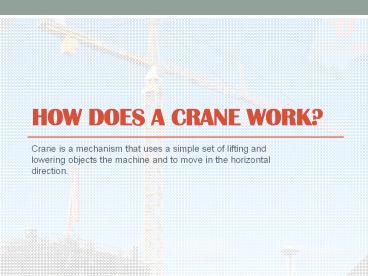How Does A Crane Work? PowerPoint PPT Presentation
Title: How Does A Crane Work?
1
How Does A Crane Work?
- Crane is a mechanism that uses a simple set of
lifting and lowering objects the machine and to
move in the horizontal direction.
2
What is a crane?
- Crane is a mechanism that uses a simple set of
lifting and lowering objects the machine and to
move in the horizontal direction. They are always
equipped with at least one winding cables, ropes
or chains and pulleys. Both pulleys and winder
are a form of a pulley.
3
Lifting
- Cranes may use a combination of simple, to get
the advantage and lifting machines, mechanical
objects. A first lever which is used in the
balance-style crane. Girder overhead crane is
balanced on a fulcrum that allows you to lift
heavy objects with fewer forces. The second style
jib crane, which uses pulleys to achieve a
mechanical advantage (but note that all cranes
use pulleys - in this case, the pulleys are the
main source of mechanical advantage). A third
method of the crane can lift the objects by a
hydraulic cylinder, either directly or by feeding
or balance the antenna.
4
Horizontal Movement
- The horizontal movement of the crane can be done
one of two ways. First, to install all the device
on a rotating axis, and a swing arm or around a
supporting beam. This is very common in mobile
cranes and derricks used in some building. The
second method is to roll the load back and forth
on rails along the pen itself. This is very
common in stationary cranes in ports and railway
stations.
5
Stability
- A final consideration in the operation of cranes
is stability. The crane is stable when the sum of
all movements on the basis of zero. In practice
this means that the size of the nominal load the
tap must be less than what would be necessary to
tilt the valve. In the United States, the mobile
crane can pick up only 85 percent of what it
would take to tip the crane bowl. This stock
should take into account the potential of the
mobile crane happens to sit instability. If you
want to buy cranes in myanmar, join with HRK
Myanmar company limited, which is one of the
leading distributors of crane in Myanmar.
6
Thanks for Watching
- www.baganmart.com
- www.facebook.com/Baganmart
- www.twitter.com/_at_BaganBlog
PowerShow.com is a leading presentation sharing website. It has millions of presentations already uploaded and available with 1,000s more being uploaded by its users every day. Whatever your area of interest, here you’ll be able to find and view presentations you’ll love and possibly download. And, best of all, it is completely free and easy to use.
You might even have a presentation you’d like to share with others. If so, just upload it to PowerShow.com. We’ll convert it to an HTML5 slideshow that includes all the media types you’ve already added: audio, video, music, pictures, animations and transition effects. Then you can share it with your target audience as well as PowerShow.com’s millions of monthly visitors. And, again, it’s all free.
About the Developers
PowerShow.com is brought to you by CrystalGraphics, the award-winning developer and market-leading publisher of rich-media enhancement products for presentations. Our product offerings include millions of PowerPoint templates, diagrams, animated 3D characters and more.

